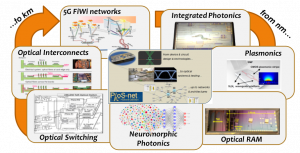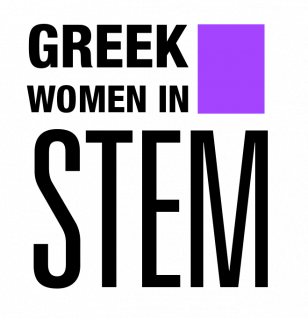Agapi Mesodiakaki, PhD is a postdoctoral researcher at the department of Informatics of the Aristotle University of Thessaloniki School of Science. She completed her studies at the Department of Electrical and Computer Engineering of the National Technical University of Athens (NTUA) specializing in Telecommunications and Computer Networks. She was then awarded the prestigious Marie Curie Scholarship for her doctoral dissertation at the Polytechnic University of Catalonia in Spain. After graduating with honors, she worked as a postdoctoral researcher at Karlstad University in Sweden. She is a member of the coordinating team of the 5G-PHOS program as well as the 5G-COMPLETE program and with more than 30 scientific publications in the field, she is currently one of the most advanced technology specialists of the next generation networks (5G). The main interests of Dr. Mesodiakaki span from managing and allocating resources to energy efficient networks, to millimeter wave networks (mmWave), converged Fiber-Wireless (FiWi) networks, optimization theory and more.
Read below about the 5G network programs Dr. Mesodiakaki works on as well as additional information she shared with us about this new technology and research.
5G-PHOS is a three-year project focusing on 5G integrated Fiber-Wireless networks. It is organized in a consortium of 16 partners and coordinated by Aristotle University of Thessaloniki. It started in September of 2017 and got funded by the European Union’s Horizon 2020 5GPPP Phase II Program. 5G-PHOS is investing heavily in cutting-edge integrated optical technologies to support four key 5G technologies, namely C-RAN (Centralized-Radio Access Network) architecture, millimeter wave (mmWave), network densification and massive Multiple-Input Multiple-Output (massive MIMO). Combining these technologies, 5G-PHOS proposes an incomparable and cost-efficient solutions. Thus, leveraging massive-MIMO, several beams can can be produced through a single fiber with multiple wavelengths (Wavelength-division Multiplexing, WDM). In addition, the use of an analog radio over fiber transmission, enables the use of higher order modulation schemes, resulting in low complexity and high spectral efficiency. Combining the above, 5G-PHOS promises data speeds of up to 100 Gbps, 10 times reduced energy consumption, while effectively addressing the problem of inefficiency of modern networks. In fact, 5G-PHOS has recently managed to experimentally demonstrate the world’s highest cumulative 5G fiber-wireless capacity transmission (24 Gbps), transmitting up to 6 data channels in parallel at speeds of up to 4 Gbps each, using mmWave antennas operating at 60 GHz.
5G-COMPLETE aims to revolutionize the 5G architecture, by efficiently combining compute and storage resource functionality over a unified ultra-high capacity converged digital/analog Fiber-Wireless (FiWi) Radio Access Network (RAN). By employing the recent advances in Ethernet fronthauling introduced by the eCPRI standard as a launching point, 5G-COMPLETE introduces and combines a series of key technologies under a unique architectural proposition that brings together i) the high capacity of fiber and high-frequency radio, ii) the audacity of converged FiWi fronthauling, iii) the spectral efficiency of analog modulation and coding schemes, iv) the flexibility of mesh self-organized networks, v) the efficiency of high-speed and time-sensitive packet-switched transport, vi) the rapid and cost-efficient service deployment through unikernel technology and finally vii) an enhanced security framework based on post-Quantum cryptosystems. 5G-COMPLETE’s proposed converged Computing/Storage/RAN infrastructure effectively merges the 5G New Radio fronthaul/midhaul/backhaul faculties into one common Ethernet-based platform and transforms the RAN into a low-power distributed computer that shapes new network concepts. 5G-COMPLETE’s results will be validated in a range of scalable lab- and field-trial demonstrators in Athens (Greece), Lannion (France) and Bristol (UK). Upon completion, 5G-COMPLETE will have introduced new business models and novel research opportunities that will be streamlined into tangible results by its 13 consortium partners that expand along the complete 5G research and market chain.
It is impressive that Greece is leading the action of the 5G-COMPLETE as well as the 5G-PHOS program. Can you describe what made the greek team excel and earn such a role?
I don’t think anyone has ever questioned Greece’s ability to produce brilliant scientists. However, what is also true is its inability to absorb and exploit them properly. That is why we see many colleagues choosing to leave the country and pursue a career abroad. To be honest, I consider this completely normal and to some extent I followed it myself. But for all of us who decide to return to the country, as long as we are armed with a lot of patience and with the scientific know-how we have gained all these years abroad, we are left with no choice but to support our choice and “succeed”. Personally, I was very lucky because upon my return I became a member of an already successful team, WinPhoS (Wireless and Photonic Systems and Networks) of Aristotle University of Thessaloniki. Our team now has about 30 members and our indisputable qualification is the writing of competent proposals for financing projects from the European Union. WinPhoS has managed to participate in over 10 European programs (FP7 and H2020) in the last 8 years, often having the coordinating role. The recipe for success I would say is the very methodical and persistent collective effort through the years. It is also noteworthy that our group expands to many different areas, as shown in the image below, starting with the very small dimensions of some nanometers with the design and implementation of chips, reaching up to those of several kilometers and the design of new architectural and improved communication networks.
In an ever-changing world, how will a 5G network affect our lives?
All next-generation networks are designed to improve our daily lives and use technology to our benefit. Therefore, 5G technology aims at average data rates of up to 10 Gbps, ultra-low latency of one millisecond (ms) and supporting of a huge number of connections at the same time. Consider that traditional networks are collapsing in very demanding operation. How many times have we happened to be at a concert or a stadium and try to upload a live broadcast or send a video and the network doesn’t respond? We are also increasingly turning to smart devices, with our washing machines, air conditioners and even coffee makers being connected to the internet. This technology, also known as Internet-of-Things (IoT), makes it imperative to transfer large volumes of data to and from multiple devices simultaneously. Also consider the need for ultra-low latency connections in autonomous driving or remote surgery. In these cases, having a long delay in transmission could mean an accident or even loss of human life. And while these scenarios seem a bit far-fetched for now, it won’t be long before they become a reality! And the only sure thing is that in this, the role of the next generation networks will be determinative.

Other than great speed and a bigger volume of transferred information, are there any other applications of your research results from these programs?
One could say that getting high-capacity networks that transfer data as fast as possible, that is, networks that can carry a large amount of useful information quickly with low packet latency is the most common issue in our industry. However, there are some other areas that are gaining more and more ground in recent years, and that are key targets of both of the aforementioned European programs I am participating in. One of them is high energy efficiency, i.e. sending a large amount of information quickly but with the lowest possible energy consumption. I think the importance of this metric can be easily understood by each one of us, e.g. if we consider how common is the problem of our phone’s battery life. Charging a cell phone used to be done on a weekly basis but is now a daily or even hourly need. And although the largest percentage of battery consumption is attributed to the lighting needs of the screen, it is still important to reduce as much as possible the corresponding percentage allocated to the use of the phone to communicate with the access point and finally with the network. This is highlighted if we consider that we now spend a lot more time at our mobile phone, using many applications and thus exchanging a large amount of data. Although this example comes from the user side, consider that for an operator it is equally important to limit the electricity bill of their network, since it is directly related to the reduction of expenses and therefore the increase of their profits. In addition, the problem of energy consumption is more relevant than ever as humanity is increasingly experiencing the effects of climate change and as we know telecommunications are responsible for 3% of global energy consumption. In this direction, both in 5G-PHOS and in 5G-COMPLETE, we emphasize which technologies we will use but also in which way in order to have a more energy efficient network. Another metric we focus on in both programs is high cost efficiency. The low cost of a service is vital both for the provider to increase their profits and ultimately for the user as this is reflected directly in their own bill.
How do you contribute to the team? What is your role?
It is true that the field of next generation networks is very broad with many different research problems that require a solution. For this reason, each of us focuses mainly on one problem and tries to put their own stone in the progress of the research. My own expertise is mainly the resource allocation algorithms as well as communication protocols in complex networks that include a variety of different technologies and that aim to energy-efficient and cost-efficient solutions. For example, although the user association problem was traditionally considered straight-forward – the users used to connect to the access point from which they received the best signal – in modern architectures, such as those we study in 5G-PHOS and in 5G-COMPLETE, this problem becomes much more complex. We have now a lot of different options in terms of technology as well as access points. Additionally, the problem is not limited there but also includes which route the user’s data flow will follow until it reaches the Core Network of the operator and get served – that is, it includes a routing problem. Finally, this data flow may not only correspond to communication but also to computational and storage needs. Given that what we choose for a user also affects the association of other users, since the resources of a network are limited, we understand the great difficulty of these algorithms that must be efficient but at the same time low complexity in order to give good solutions quickly. In sum, my role in the team revolves around this research object and includes creating new proposals, simulations and theoretical modeling and extracting results, writing scientific articles, participation and representation of our team in international conferences, as well as project management and creation and coordination of new proposals for possible funding.
There are rumors these days about 5G networks. Can you share your scientific opinion on whether they can be considered safe for health?
This is the most common question I hear about 5G from friends and acquaintances. What effect will it have on our health? In fact, many videos have been released on the internet with conspiracy theories, but unfortunately, they are not based on scientific facts. I fully understand the concerns on this issue as we are talking about new technologies that many people are unfamiliar with. However, I consider it necessary to have good information based on reliable sources before anyone stands up against the introduction of a new technology. Based on the information we have so far, 5G and other wireless technologies that we use nowadays, have not been shown to have a detrimental effect on our health, as the World Health Organization concludes. Also consider that no base station can operate without meeting the strict specifications set for the maximum allowable limits of radiated electromagnetic power. The radiated power is actually not at all close to these limits but many times lower. We should also be more interested in the percentage of radiation we receive during a call from the cell phone next to our ear, rather than the signal we receive from an antenna that reaches us quite weakened. Another thing that may not be widely known is that our mobile phone emits much less power on a network where the access point is close, while on the contrary in areas with poor coverage the device is forced to transmit at maximum power to communicate with the access point. This is also the reason why the use of the mobile phone should be avoided indoors without coverage, such as e.g. in the subway carriages where no access points have been installed, since on the one hand successful communication is not achieved and on the other hand the mobile phone radiates with maximum power thus consuming a lot of battery. Of course, there are reports against exclusively 5G and not electromagnetic radiation in general. These reports mainly focus on the use of higher frequencies at 5G, i.e. millimeter wave, and the existence of a massive number of antennas. In fact, these high frequencies attenuate at a much higher pace than the sub-6 GHz frequencies that are traditionally used. This is why you need so many more antennas to cover an area. However, it does not in any way mean that the radiation received by the user is greater, given that these antennas are very directional (very thin beams are created – pencil beams – between transmitter and receiver) and so the radiation in other directions can be considered negligible. In addition, it is important that 5G networks are much smarter, and aim for the highest possible energy efficiency, as we said before. As a result, 5G antennas emit only when necessary and at the lowest possible power to consume as little power as possible. In summary, I would say that 5G has more to offer than to get from the health sector, especially if we consider the applications that it may have e.g. in telemedicine.
You have excelled in two other European countries, but now you live in Greece. What is the most positive part – solely scientifically- that you observe in our country?
I think that what would stand out from my return to work in Greece is the human environment. The climate is quite cooperative, you become a member of the team from the first days and you evolve quickly. Interaction with colleagues helps a lot in this development, as they are people who spend pleasant time guiding you or solving any questions you may have. Unfortunately, while abroad, this is a very slow process due to cultural differences. Some people are even more closed than others, so integration into the group is something that takes a long time and may never come to the desired level. Also, apart from the cooperation, it is not uncommon for us and our colleagues to do “a little extra”. In other words, work ceases to be a laborious task, but becomes a challenge that we are called together as a team to face with dedication and joy.
Is there any area where you would like more support / improvement?
I think I will give a mainstream answer to this question, I would like to reduce bureaucracy. Unfortunately, in this area we are far behind as a country. Things that for a Northern European are unquestionable benefits, such as e.g. obtaining a simple certificate with one click, here seemed for several years a science fiction scenario. For example, starting my work in Sweden was a very enjoyable and quick process, with the vast majority of actions taking place online. Here, unfortunately, this automatically means a long wait in line and a high latency. Also, to give another example, when we, as a University, undertake the coordination or even the participation in a European Program, the process that must be followed does not help us at all, thus complicating our work. Of course, I must acknowledge that some ambitious efforts have been made by the country recently to make e-government as effective as possible. Let’s hope we continue like this and even better.
What comes after 5G? Do you know / predict in which direction network research will continue?
Research must always be one step ahead of adopting and implementing a new technology. So even though 5G networks are not yet fully developed around the world, we are already studying the era after the 5G or “beyond 5G” era as it is called. At the same time, reports have begun on the 6G. Of course, a common feature of these next-generation networks is their improved performance in all the metrics mentioned above. A main component is new technologies, such as even higher frequencies in the Terahertz (THz) region, increased security, as well as human-machine interaction with many voice recognition interfaces, facial expressions, sounds, etc., as well as the use of machine learning so that networks discover errors, faults and security problems quickly without human intervention making them much more robust and therefore much more functional.

MORE TOPICS
CATEGORY 1 CATEGORY 2 CATEGORY 3 CATEGORY 4
CONTACT US
____________
greekwomeninstem@gmail.com
Do you have ideas, questions, comments or special requests?
Would you like to highlight your research project or nominate a researcher that you would like to learn more about?
Please write to our email or fill out the form and hit “send”. We will be happy to talk with you!
[contact-form-7 id=”44″ title=”Contact form 1″]
